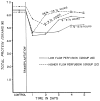THE USE OF COMBINED PRESERVATION TECHNIQUES FOR EXTENDED STORAGE OF ORTHOTOPIC LIVER HOMOGRAFTS
- PMID: 21188295
- PMCID: PMC3008811
THE USE OF COMBINED PRESERVATION TECHNIQUES FOR EXTENDED STORAGE OF ORTHOTOPIC LIVER HOMOGRAFTS
Figures





References
-
- Ackermann JRW, Barnard CN. A report on the successful storage of kidneys. Brit J Surg. 1966;53:525. - PubMed
-
- Brown H, Patel J, Blair DW, Brown ME. Biochemical studies with preserved transplanted canine liver. J Am M Ass. 1966;196:775. - PubMed
-
- Goodrich ED, Welsh HF, Nelson JA, Beecher TS, Welch CS. A report on homotransplantation of the canine liver. Surgery. 1956;39:244. - PubMed
-
- Kestens PJ, McDermott WV., Jr Perfusion and replacement of the canine liver. Surgery. 1961;50:196. - PubMed
Grants and funding
LinkOut - more resources
Full Text Sources
